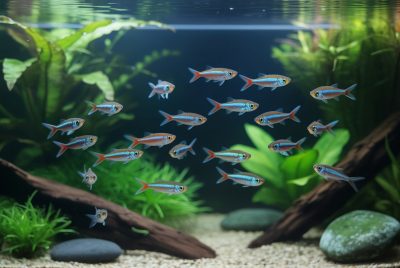Fish Communication: How Fish Use Sounds, Colors, and Movements
*We may earn a commission for purchases made using our links. Please see our disclosure to learn more.
Imagine diving into the crystal-clear waters of a coral reef, surrounded by what appears to be a silent underwater world. Yet beneath this perceived tranquility lies one of nature’s most sophisticated communication networks. Fish have been perfecting their underwater languages for millions of years, developing intricate systems of sounds, visual displays, and body movements that rival any human communication method in complexity and effectiveness.
“The ocean is not silent. It’s full of sounds that we’re only beginning to understand—clicks, grunts, pops, and whistles that form the complex vocabulary of marine life.”
– Marine Biology Research Institute
Key Takeaways
- Fish use three primary communication methods: acoustic signals, visual displays, and body movements
- Sound travels efficiently underwater: Many fish species produce and detect sounds for various purposes
- Color changes serve multiple functions: From camouflage to mating displays and territorial warnings
- Body language is universal: Fish use specific movements and postures to convey messages
- Communication varies by species: Each fish species has evolved unique communication strategies
- Environmental factors influence communication: Water clarity, depth, and habitat affect how fish communicate
The Hidden Symphony of Underwater Sounds
The Acoustic Landscape
The underwater world pulses with a constant symphony of sounds that most surface dwellers never experience. Fish communication through sound represents one of the most remarkable adaptations in the animal kingdom. Unlike terrestrial animals, fish have evolved to take advantage of water’s superior sound-conducting properties, where acoustic signals can travel four times faster than in air.
Many fish species produce sounds through specialized organs called sonic muscles, which rapidly contract against their swim bladders to create drumming sounds. Others use their pharyngeal teeth—grinding them together to produce clicking or popping noises that can travel significant distances through water. The diversity of these acoustic signals is staggering, ranging from the deep, resonant calls of large groupers to the high-frequency clicks of smaller reef fish.
Purpose-Driven Acoustic Communication
Fish employ acoustic communication for numerous vital purposes. During spawning season, many species use specific sound patterns to attract mates and coordinate reproductive activities. Male fish often produce repetitive calling sounds that serve as underwater love songs, advertising their presence and genetic fitness to potential partners. These mating calls can be species-specific, ensuring that fish find appropriate mates even in crowded reef environments.
Territorial disputes also involve complex acoustic exchanges. Fish use threatening sounds to establish dominance and defend their territories without resorting to physical confrontation. These warning calls often involve rapid bursts of sound that escalate in intensity, serving as an underwater equivalent of aggressive posturing.
The Challenge of Underwater Acoustics
Creating and interpreting sounds underwater presents unique challenges that fish have ingeniously overcome. Sound attenuation, background noise from waves and currents, and the need to pinpoint sound sources in three-dimensional space have all shaped the evolution of fish hearing and sound production. Many species have developed highly sensitive lateral line systems that detect water movements and pressure changes, complementing their acoustic communication abilities.
Visual Spectacles: The Language of Color and Light
Dynamic Color Communication
The visual communication methods employed by fish represent some of nature’s most stunning displays. Fish have evolved sophisticated chromatophore systems—specialized cells containing pigments that can be rapidly expanded or contracted to create instantaneous color changes. These dynamic displays serve as a real-time communication system that can convey emotions, intentions, and social status with remarkable precision.
Color changes in fish serve multiple communication functions simultaneously. During courtship, many species display vibrant breeding colors that signal reproductive readiness and genetic fitness. These displays can be incredibly elaborate, with some fish cycling through multiple color patterns in rapid succession to create mesmerizing visual performances that attract potential mates.
Territorial and Social Signaling
Beyond reproduction, fish use color changes to establish and maintain social hierarchies. Dominant fish often display bold, bright colors that advertise their status, while subordinate individuals may adopt more muted tones to avoid confrontation. This visual communication system allows fish communities to maintain social order with minimal physical aggression.
The speed and versatility of color communication provide fish with a sophisticated signaling system that can adapt to changing circumstances. A fish can shift from aggressive warning colors to submissive patterns in seconds, allowing for nuanced social interactions that rival those of more complex vertebrates.
Environmental Adaptation
Fish also use color changes for environmental communication—signaling to other fish about local conditions or threats. Some species employ specific color patterns to indicate the presence of predators, while others use camouflage techniques that communicate their emotional state to nearby individuals. This environmental adaptation demonstrates the multifaceted nature of fish visual communication.
The Art of Movement: Body Language Beneath the Waves
Sophisticated Movement Patterns
Fish body language represents perhaps the most universal form of aquatic communication. Every movement, from subtle fin adjustments to dramatic full-body displays, carries meaning that other fish can interpret and respond to accordingly. These movement patterns have evolved to be clearly visible underwater, taking advantage of the way water amplifies and carries motion signals.
Swimming patterns often convey specific messages about a fish’s intentions and emotional state. Aggressive fish may adopt rigid, angular swimming patterns with erect fins, while submissive individuals display more fluid, curved movements. These behavioral displays allow fish to communicate their intentions before physical contact becomes necessary.
Courtship and Mating Displays
During reproductive seasons, fish movement communication becomes particularly elaborate. Courtship displays often involve complex choreographed swimming patterns that can last for hours. Male fish may perform intricate figure-eight patterns, rapid directional changes, or synchronized swimming routines that demonstrate their fitness and coordination to potential mates.
These mating displays represent some of the most sophisticated behavioral communication in the animal kingdom. Fish must coordinate their movements precisely, often incorporating elements of sound and color changes to create multimedia presentations that effectively communicate their reproductive intentions.
Threat Assessment and Defense
Fish also use movement patterns to assess and respond to threats. Schooling fish employ coordinated movement communication to share information about predator locations and escape routes. Individual fish within a school can communicate danger through specific movement patterns that propagate through the group faster than visual detection alone would allow.
Defensive movements often involve specific postures and swimming patterns that make fish appear larger or more threatening to potential predators. These displays can be combined with color changes and acoustic signals to create comprehensive threat responses that maximize survival chances.
Species-Specific Communication Strategies
Reef Fish Communities
Coral reef environments host some of the most complex fish communication systems on Earth. The diversity of species living in close proximity has driven the evolution of highly specific communication methods that minimize confusion and maximize effectiveness. Reef fish have developed sophisticated ways to distinguish between species-specific signals and general environmental communications.
Cleaner fish and their clients demonstrate one of the most remarkable examples of interspecies communication. These relationships involve complex visual and tactile signals that allow different species to communicate their needs and intentions clearly. The precision of these communications enables mutually beneficial relationships that have persisted for millions of years.
Deep-Sea Adaptations
Deep-sea fish face unique communication challenges due to the absence of natural light and the vast distances between individuals. Many deep-sea species have evolved bioluminescent communication systems that create light patterns visible in the eternal darkness of the ocean depths. These living light displays serve as beacons for mating, territorial marking, and predator deterrence.
The acoustic properties of deep water also influence communication strategies. Deep-sea fish often produce low-frequency sounds that can travel enormous distances through the water column, allowing them to communicate across vast oceanic spaces that would be impossible for surface species.
Freshwater Innovations
Freshwater fish have developed communication strategies adapted to their specific environments. Rivers and lakes present different acoustic and visual challenges than marine environments, leading to unique evolutionary solutions. Many freshwater species rely heavily on chemical communication combined with acoustic and visual signals to navigate the complex sensory environment of rivers and lakes.
Environmental Influences on Fish Communication
Water Quality and Clarity
The effectiveness of fish communication depends heavily on environmental conditions. Water clarity affects visual communication range and effectiveness, while temperature and salinity influence sound transmission properties. Fish have evolved flexible communication strategies that can adapt to changing environmental conditions while maintaining effectiveness.
Pollution and human activities increasingly interfere with natural fish communication systems. Noise pollution from boat traffic and industrial activities can mask acoustic signals, while chemical pollutants can interfere with both visual and chemical communication methods. Understanding these impacts is crucial for marine conservation efforts.
Seasonal and Daily Variations
Fish communication patterns often follow seasonal and daily rhythms that align with natural environmental cycles. Spawning seasons typically involve intensified communication activities, while feeding periods may require more subtle signaling to avoid attracting predators. These temporal variations demonstrate the sophisticated ways fish integrate communication with their ecological needs.
Light availability strongly influences visual communication effectiveness, leading many fish species to adjust their communication strategies based on time of day and seasonal light conditions. This flexibility allows fish to maintain effective communication throughout varying environmental conditions.
The Future of Fish Communication Research
Technological Advances
Modern technology is revolutionizing our understanding of fish communication. Underwater recording equipment, high-speed cameras, and sophisticated analysis software are revealing previously unknown aspects of aquatic communication. These tools are uncovering the complexity and sophistication of fish communication systems that were once invisible to human observation.
Genetic research is also contributing to our understanding of fish communication evolution. By studying the genetic basis of communication-related traits, scientists are beginning to understand how these remarkable systems evolved and continue to adapt to changing environments.
Conservation Implications
Understanding fish communication has important implications for marine conservation efforts. Protecting critical communication habitats, reducing noise pollution, and maintaining water quality are all essential for preserving natural fish communication systems. These considerations are becoming increasingly important as human activities continue to impact marine environments.
The study of fish communication also provides insights into the broader ecological relationships that depend on effective aquatic communication. From predator-prey relationships to symbiotic partnerships, fish communication underpins many of the complex interactions that maintain healthy marine ecosystems.
Conclusion
The underwater world of fish communication represents one of nature’s most remarkable achievements. Through millions of years of evolution, fish have developed sophisticated systems of sounds, colors, and movements that enable complex social interactions, successful reproduction, and survival in challenging aquatic environments. These communication systems rival any found in the animal kingdom in their complexity, effectiveness, and beauty.
As we continue to explore and understand these aquatic languages, we gain deeper appreciation for the intelligence and adaptability of marine life. The sounds, colors, and movements of fish communication remind us that the ocean is far from silent—it’s alive with conversations, negotiations, and relationships that sustain the rich diversity of aquatic life.
The future of fish communication research promises to reveal even more about these remarkable systems. As technology advances and our understanding deepens, we’ll undoubtedly discover new aspects of fish communication that will continue to amaze and inspire us. Protecting these communication systems and the environments that support them remains crucial for maintaining the health and diversity of our planet’s aquatic ecosystems.
Frequently Asked Questions
Q: Can fish really hear sounds underwater?
A: Yes, fish can hear sounds underwater and many species have excellent hearing abilities. They use specialized organs called otoliths and lateral line systems to detect sound waves and water movements. Some fish can even distinguish between different types of sounds and respond appropriately to acoustic signals from other fish.
Q: How do fish change colors so quickly?
A: Fish change colors using specialized cells called chromatophores that contain different colored pigments. These cells can rapidly expand or contract, making the pigments more or less visible. The process is controlled by the nervous system and can happen in seconds, allowing fish to change colors almost instantaneously in response to their environment or emotions.
Q: Do all fish species communicate the same way?
A: No, different fish species have evolved unique communication methods adapted to their specific environments and needs. While many fish use combinations of sounds, colors, and movements, the specific signals and meanings vary greatly between species. Reef fish might rely more on visual displays, while deep-sea fish might depend more on bioluminescent signals.
Q: Can fish communicate with different species?
A: Yes, some fish can communicate across species boundaries, particularly in symbiotic relationships. The best example is cleaner fish and their clients, where different species use specific signals to communicate their needs. However, most detailed communication occurs within the same species, as the signals are often species-specific.
Q: How far can fish communication signals travel underwater?
A: The distance varies greatly depending on the type of signal and environmental conditions. Acoustic signals can travel several kilometers in optimal conditions, especially low-frequency sounds in deep water. Visual signals are limited by water clarity and light availability, typically effective within a few meters to hundreds of meters. Movement patterns are generally effective at shorter ranges but can be detected by sensitive lateral line systems at moderate distances.




